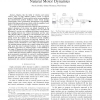Free Online Productivity Tools
i2Speak
i2Symbol
i2OCR
iTex2Img
iWeb2Print
iWeb2Shot
i2Type
iPdf2Split
iPdf2Merge
i2Bopomofo
i2Arabic
i2Style
i2Image
i2PDF
iLatex2Rtf
Sci2ools
IJRR
2007
2007
Wave Haptics: Building Stiff Controllers from the Natural Motor Dynamics
— Haptics, like the fields of robotics and motion control, relies on high stiffness position control of electric motors. Traditionally DC motors are driven by current amplifiers and encoder-based position feedback creates virtual springs. Unfortunately, sensor quantization, discretization, and amplifier bandwidths impose performance limits, while the amplifiers work hard to cancel the motor’s electrical dynamics. We present an alternate approach noting the natural inductorresistor dynamics of the motor are indeed beneficial to the haptic task. We follow two main insights: First, the electrical inductance L can serve as a stiffness, providing a natural sensorless coupling between the virtual environment and the user. This physical effect is available at all frequencies and can be exploited in the bandwidth of human perception through an analog circuit that replaces the traditional current amplifier. Second, the analog circuit uses the electrical resistance R to create a natura...
| Added | 15 Dec 2010 |
| Updated | 15 Dec 2010 |
| Type | Journal |
| Year | 2007 |
| Where | IJRR |
| Authors | Nicola Diolaiti, Günter Niemeyer, Neal A. Tanner |
Comments (0)

